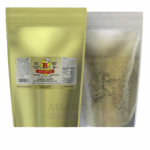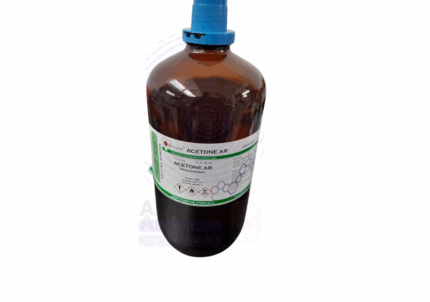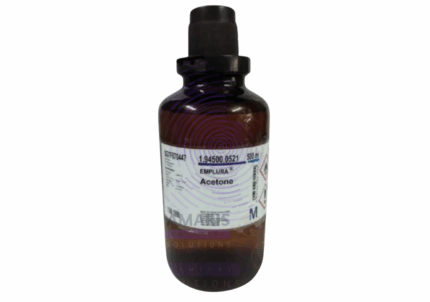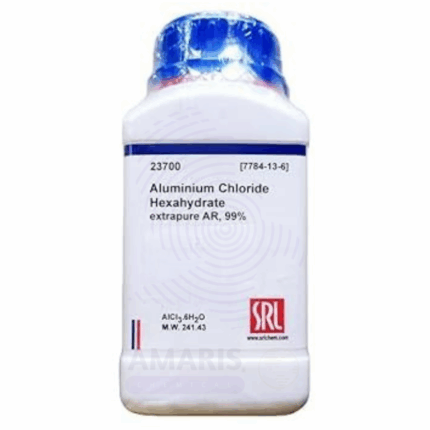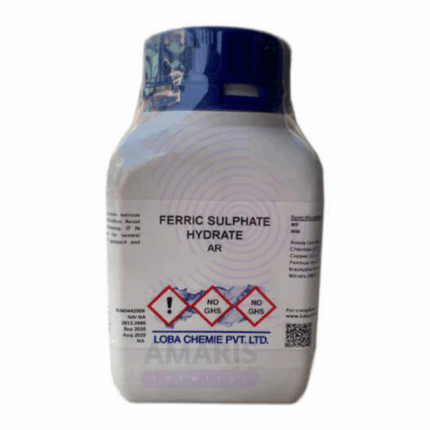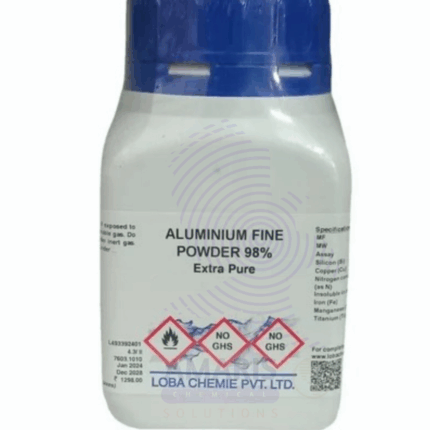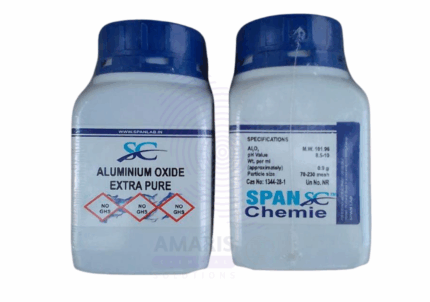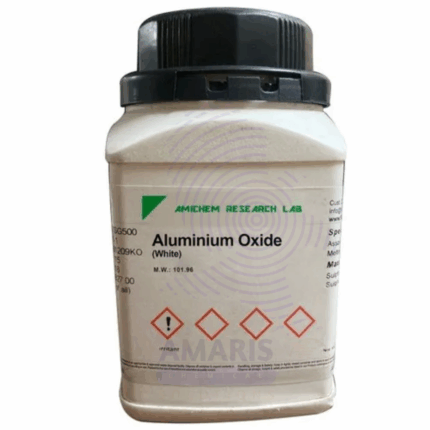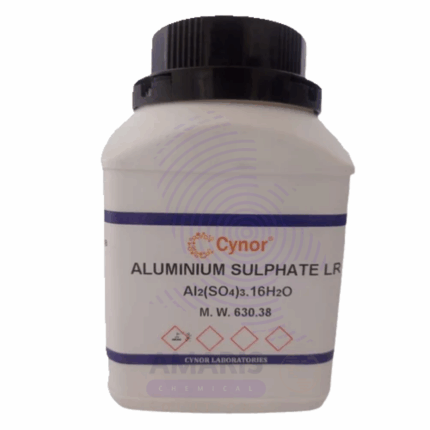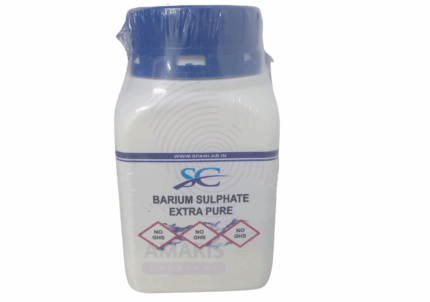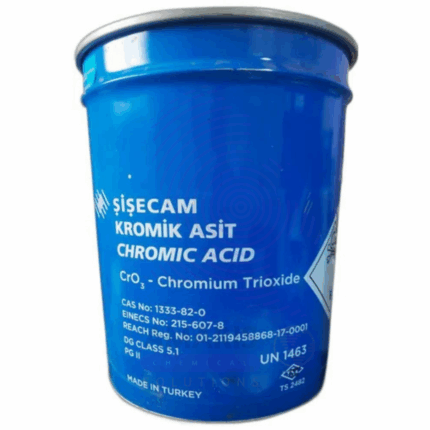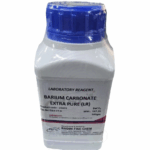
Barium Acetate Extra Pure
$ 18.00 Original price was: $ 18.00.$ 17.34Current price is: $ 17.34.
Barium Acetate Extra Pure is a high-purity, white crystalline compound used in laboratory chemistry for analytical, inorganic, and materials science applications. It serves as a soluble source of barium ions in solution, making it valuable for studies involving double displacement reactions, sulfate detection, and synthesis of other barium salts. Its use in gravimetric analysis and as a precursor in the preparation of specialty ceramics and optical materials is also notable. The extra pure grade ensures low impurity levels, supporting accurate and consistent results in high-precision research. It should be stored in tightly sealed containers in a cool, dry place, away from acids and moisture to maintain its chemical integrity.
Barium Acetate Extra Pure
Primary Uses
- Precursor in Barium Compound Synthesis
- Used to prepare other barium salts, such as barium chromate, carbonate, sulfate, and phosphate via precipitation reactions.
- Reagent for Sulfate and Chromate Ion Detection
- Reacts with sulfate (SO₄²⁻) and chromate (CrO₄²⁻) to form insoluble barium salts, used in qualitative analysis and gravimetric determination.
- Source of Barium Ions in Inorganic Reactions
- Supplies Ba²⁺ in ionic equilibrium studies, precipitation tests, and ion-exchange experiments.
- Flame Test Reagent for Teaching Labs
- Used to demonstrate green barium flame coloration, aiding in elemental identification.
- Model Compound in Solubility Product (Ksp) Experiments
- Helps students understand solubility equilibria and predict outcomes of double displacement reactions.
Secondary Uses
- Component in Conductivity and Ion Transport Studies
- Useful in exploring the mobility of divalent ions and their interactions with anions in solution.
- Synthesis of Barium-Based Coordination Complexes
- Serves as a starting material for ligand binding and structural studies involving barium and carboxylate groups.
- pH Adjustment and Buffering in Non-Critical Applications
- The acetate component offers mild buffering capacity in some inorganic solutions.
- Research on Acetate Salt Stability and Hydration
- Investigated for its thermal decomposition, hydration behavior, and crystal structure in solid-state chemistry.
- Simulation of Environmental Precipitation Reactions
- Used to model ion removal in water treatment and pollutant precipitation processes in environmental labs.
| PACK SIZE |
500 grams Plastic Tin |
|---|
1. Basic Identification Attributes
- Chemical Name: Barium Acetate
- CAS Number: 543-80-6
- HS Code: 29152990 (Salts of acetic acid – other)
- Molecular Formula: Ba(C₂H₃O₂)₂
- Synonyms:
- Barium diacetate
- Acetic acid, barium salt
- Barium ethanoate
2. Physical & Chemical Properties
- Physical State: Solid (crystalline powder or granules)
- Color & Odor: White; odorless
- Boiling Point: Decomposes before boiling
- Melting Point: ~450 °C (decomposes)
- Density/Specific Gravity: ~2.47 g/cm³
- Solubility:
- Water: Soluble (~55 g/100 mL at 0 °C)
- Alcohol: Slightly soluble
- pH Level: ~7–8 (neutral to slightly basic in aqueous solution)
- Vapor Pressure: Negligible
- Flash Point: Not flammable
- Autoignition Temperature: Not applicable
- Viscosity: Not applicable
3. Safety & Hazard Attributes
- Hazard Class (GHS):
- Acute Toxicity – Oral (Category 3)
- May cause damage to organs if ingested
- NFPA Ratings:
- Health: 3
- Flammability: 0
- Reactivity: 0
- Exposure Limits:
- OSHA PEL (as soluble barium compounds): 0.5 mg/m³ (as Ba)
- ACGIH TLV: 0.5 mg/m³ (as Ba)
- Reactivity:
- Stable under normal conditions
- Incompatible with strong acids and oxidizers
4. Storage & Handling Attributes
- Storage Conditions:
- Store in cool, dry, tightly sealed containers
- Protect from moisture and acids
- Incompatible Materials:
- Strong acids (release toxic barium ions)
- Oxidizers, carbonates, sulfates
- Container Type:
- Sealed glass or HDPE containers
- Shelf Life & Expiration Date:
- ~2–3 years if kept dry
- Special Handling Requirements:
- Use gloves, goggles, and dust mask
- Prevent dust inhalation and ingestion
5. Regulatory & Compliance Attributes
- Regulatory Status:
- Listed under TSCA and REACH
- Regulated due to toxicity of barium
- Transportation Restrictions:
- Not classified as hazardous for transport in small lab quantities
- Waste Disposal Method:
- Dispose as hazardous waste (due to soluble barium)
- Never pour down the drain
6. Environmental & Health Impact
- Ecotoxicity:
- Very toxic to aquatic life
- Persistence in Environment:
- Inorganic; does not degrade but may accumulate
- Carcinogenicity/Mutagenicity:
- Not classified as carcinogenic
- Biodegradability:
- Not biodegradable
SAFETY PRECAUTIONS
- Personal Protective Equipment (PPE):
- Wear chemical-resistant gloves (nitrile or neoprene), lab coat, and chemical splash goggles.
- Use in a fume hood or well-ventilated space to avoid inhaling dust.
- Handling:
- Avoid inhalation of dust, ingestion, and contact with skin and eyes.
- Handle with care—toxic if swallowed or absorbed.
- Do not mix with acids—may release acetic acid fumes.
- Storage:
- Store in a cool, dry, well-ventilated place.
- Keep in tightly closed containers, away from acids, moisture, and oxidizing agents.
- Clearly label as toxic.
- Hygiene Measures:
- Wash hands thoroughly after handling.
- Do not eat, drink, or smoke in the lab.
- Clean spills immediately with non-metallic absorbents.
FIRST AID MEASURES
- Inhalation:
- Move the person to fresh air immediately.
- Seek immediate medical attention if respiratory symptoms occur (cough, shortness of breath, chest discomfort).
- Skin Contact:
- Rinse skin with plenty of water and soap.
- Remove contaminated clothing.
- Seek medical attention if irritation develops.
- Eye Contact:
- Flush eyes immediately with water for at least 15 minutes, lifting eyelids occasionally.
- Remove contact lenses if present.
- Seek medical attention immediately.
- Ingestion:
- Do NOT induce vomiting.
- Rinse mouth thoroughly with water.
- Give water or milk if the person is conscious.
- Seek emergency medical attention—barium compounds are highly toxic, potentially causing:
- Muscle weakness
- Vomiting
- Cardiac arrhythmias
- Hypokalemia
FIRE FIGHTING MEASURES
- Suitable Extinguishing Media:
- Use dry chemical, carbon dioxide (CO₂), foam, or water spray.
- Specific Hazards:
- Not flammable, but may decompose on heating, emitting:
- Toxic barium oxide fumes
- Carbon monoxide (CO)
- Carbon dioxide (CO₂)
- Acetic acid vapors
- Not flammable, but may decompose on heating, emitting:
- Protective Equipment:
- Wear self-contained breathing apparatus (SCBA) and full protective gear.
- Firefighting Instructions:
- Cool exposed containers with water spray.
- Avoid inhaling combustion fumes.
- Prevent contaminated runoff from reaching drains or waterways.


 Preservatives(food)
Preservatives(food) Flavor Enhancers
Flavor Enhancers Acidulants
Acidulants Sweeteners
Sweeteners Antioxidants
Antioxidants Colorants(food)
Colorants(food) Nutraceutical Ingredients (food)
Nutraceutical Ingredients (food) Nutrient Supplements
Nutrient Supplements Emulsifiers
Emulsifiers
 Collectors
Collectors Dust Suppressants
Dust Suppressants Explosives and Blasting Agents
Explosives and Blasting Agents Flocculants and Coagulants
Flocculants and Coagulants Frothers
Frothers Leaching Agents
Leaching Agents pH Modifiers
pH Modifiers Precious Metal Extraction Agents
Precious Metal Extraction Agents
 Antioxidants(plastic)
Antioxidants(plastic) Colorants (Pigments, Dyes)
Colorants (Pigments, Dyes) Fillers and Reinforcements
Fillers and Reinforcements Flame Retardants
Flame Retardants Monomers
Monomers Plasticizers
Plasticizers Polymerization Initiators
Polymerization Initiators Stabilizers (UV, Heat)
Stabilizers (UV, Heat)
 Antifoaming Agents
Antifoaming Agents Chelating Agents
Chelating Agents Coagulants and Flocculants
Coagulants and Flocculants Corrosion Inhibitors
Corrosion Inhibitors Disinfectants and Biocides
Disinfectants and Biocides Oxidizing Agents
Oxidizing Agents pH Adjusters
pH Adjusters Scale Inhibitors( water)
Scale Inhibitors( water)
 Antioxidants(cosmetic)
Antioxidants(cosmetic) Emollients
Emollients Fragrances and Essential Oils
Fragrances and Essential Oils Humectants
Humectants Preservatives
Preservatives Surfactants(cosmetic)
Surfactants(cosmetic) Thickeners
Thickeners UV Filters
UV Filters
 Fertilizers
Fertilizers Soil Conditioners
Soil Conditioners Plant Growth Regulators
Plant Growth Regulators Animal Feed Additives
Animal Feed Additives Biostimulants
Biostimulants Pesticides (Herbicides, Insecticides, Fungicides)
Pesticides (Herbicides, Insecticides, Fungicides)
 Active Pharmaceutical Ingredients (APIs)
Active Pharmaceutical Ingredients (APIs) Excipients
Excipients Solvents(pharmaceutical)
Solvents(pharmaceutical) Antibiotics
Antibiotics Antiseptics and Disinfectants
Antiseptics and Disinfectants Vaccine Adjuvants
Vaccine Adjuvants Nutraceutical Ingredients (pharmaceutical)
Nutraceutical Ingredients (pharmaceutical) Analgesics & Antipyretics
Analgesics & Antipyretics
 Analytical Reagents
Analytical Reagents Solvents(lab)
Solvents(lab) Chromatography Chemicals
Chromatography Chemicals Spectroscopy Reagents
Spectroscopy Reagents microbiology-and-cell-culture-reagents
microbiology-and-cell-culture-reagents Molecular Biology Reagents
Molecular Biology Reagents Biochemical Reagents
Biochemical Reagents Inorganic and Organic Standards
Inorganic and Organic Standards Laboratory Safety Chemicals
Laboratory Safety Chemicals Specialty Laboratory Chemicals(Special Laboratory Equipment)
Specialty Laboratory Chemicals(Special Laboratory Equipment)
 Demulsifiers
Demulsifiers Hydraulic Fracturing Fluids
Hydraulic Fracturing Fluids Scale Inhibitors(oil)
Scale Inhibitors(oil) Surfactants(oil)
Surfactants(oil) Drilling Fluids
Drilling Fluids
 Dyes and Pigments
Dyes and Pigments Bleaching Agents
Bleaching Agents Softening Agents
Softening Agents Finishing Agents
Finishing Agents Antistatic Agents
Antistatic Agents
 Admixtures
Admixtures Waterproofing Agents
Waterproofing Agents Sealants and Adhesives
Sealants and Adhesives Curing Compounds
Curing Compounds Concrete Repair Chemicals
Concrete Repair Chemicals Anti-Corrosion Coatings
Anti-Corrosion Coatings
 Surfactants(cleaning)
Surfactants(cleaning) Builders
Builders Enzymes
Enzymes Solvents (Cleaning)
Solvents (Cleaning) Fragrances
Fragrances
 Electronic Chemicals
Electronic Chemicals Catalysts
Catalysts Lubricants
Lubricants Photographic Chemicals
Photographic Chemicals Refrigerants
Refrigerants Automotive chemicals
Automotive chemicals Pyrotechnic Chemicals
Pyrotechnic Chemicals
 Biodegradable Surfactants
Biodegradable Surfactants Bio-based Solvents
Bio-based Solvents Renewable Polymers
Renewable Polymers Carbon Capture Chemicals
Carbon Capture Chemicals Wastewater Treatment Chemicals
Wastewater Treatment Chemicals
 Pigments
Pigments Solvents(paint)
Solvents(paint) Specialty Coatings
Specialty Coatings Binders/Resins
Binders/Resins Additives
Additives Driers
Driers Anti-Corrosion Agents
Anti-Corrosion Agents Functional Coatings
Functional Coatings Application-Specific Coatings
Application-Specific Coatings
 Fresh Herbs
Fresh Herbs Ground Spices
Ground Spices Whole Spices
Whole Spices Spice Blends
Spice Blends Dried Herbs
Dried Herbs
 Leavening Agents
Leavening Agents Dough Conditioners
Dough Conditioners Flour Treatments
Flour Treatments Fat Replacers
Fat Replacers Decoratives
Decoratives Preservatives(baking)
Preservatives(baking)
 Plasticizers & Softeners
Plasticizers & Softeners Reinforcing Agents
Reinforcing Agents Adhesion Promoters
Adhesion Promoters Vulcanizing Agents
Vulcanizing Agents Antidegradants
Antidegradants Blowing Agents
Blowing Agents Fillers & Extenders
Fillers & Extenders Accelerators & Retarders
Accelerators & Retarders
